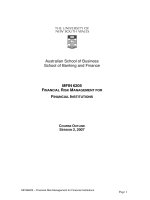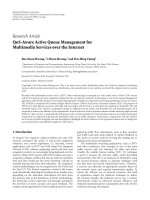Economic capital and financial risk management for financial services firms and conglomerates bruce t porteous and pradip tapadar
Bạn đang xem bản rút gọn của tài liệu. Xem và tải ngay bản đầy đủ của tài liệu tại đây (1.68 MB, 344 trang )
Economic Capital and
Financial Risk Management
for Financial Services Firms
and Conglomerates
Bruce T. Porteous and
Pradip Tapadar
Economic Capital
and Financial Risk Management
for Financial Services Firms
and Conglomerates
B R U C E T. P O R T E O U S
AND
P R A D I P TA PA D A R
© Bruce T. Porteous and Pradip Tapadar 2006
All rights reserved. No reproduction, copy or transmission of this
publication may be made without written permission.
No paragraph of this publication may be reproduced, copied or transmitted
save with written permission or in accordance with the provisions of the
Copyright, Designs and Patents Act 1988, or under the terms of any licence
permitting limited copying issued by the Copyright Licensing Agency, 90
Tottenham Court Road, London W1T 4LP.
Any person who does any unauthorized act in relation to this publication
may be liable to criminal prosecution and civil claims for damages.
The authors have asserted their rights to be identified
as the authors of this work in accordance with the Copyright,
Designs and Patents Act 1988.
First published in 2006 by
PALGRAVE MACMILLAN
Houndmills, Basingstoke, Hampshire RG21 6XS and
175 Fifth Avenue, New York, N.Y. 10010
Companies and representatives throughout the world.
PALGRAVE MACMILLAN is the global academic imprint of the Palgrave
Macmillan division of St. Martin’s Press, LLC and of Palgrave Macmillan Ltd.
Macmillan® is a registered trademark in the United States, United Kingdom
and other countries. Palgrave is a registered trademark in the European
Union and other countries.
ISBN-13: 978–1–4039–3608–0
ISBN-10: 1–4039–3608–0
This book is printed on paper suitable for recycling and made from fully
managed and sustained forest sources.
A catalogue record for this book is available from the British Library.
A catalog record for this book is available from the Library of Congress.
10 9 8 7 6 5 4 3 2 1
15 14 13 12 11 10 09 08 07 06
Printed and bound in Great Britain by
Antony Rowe Ltd, Chippenham and Eastbourne
Contents
List of Figures
List of Tables
Preface
Acknowledgments
Disclaimer
List of Abbreviations
vii
xiii
xv
xviii
xix
xx
1 Introduction
1.1 Our approach to risk
1.2 Our approach to capital
1.3 Our approach to infrastructure
1.4 Structure of the book
1
1
2
2
3
2 Risk Types, Collection and Mitigation
2.1 Introduction
2.2 Types of risks collected
2.3 Risk collection
2.4 Risk mitigants
2.5 Summary
5
5
6
13
16
19
3 Risk Governance
3.1 Introduction
3.2 Risk identification
3.3 Risk management infrastructure
and processes
3.4 Risk measures, appetite and limits
3.5 Relate capital to risk
3.6 Reporting processes
3.7 Independent reviews of internal controls
3.8 Summary
21
21
22
25
27
30
31
32
33
iii
iv
CONTENTS
4
Stress Testing to Measure Risk
4.1 Introduction
4.2 Deterministic stresses
4.3 Stochastic stresses
4.4 Multivariate nature of the risk variables
4.5 Causal nature of the multivariate dependencies
4.6 Mathematical tractability
4.7 Stress confidence level
4.8 Relative pros and cons
4.9 Summary
34
34
34
35
37
38
39
39
40
41
5
Economic Capital
5.1 Defining economic capital
5.2 Time horizon for determining economic capital
5.3 Exclusion of the capital assets backing a firm’s
business
5.4 Expected losses versus unexpected losses
5.5 Uses of economic capital
5.6 Economic capital calculation in practice
5.7 Relationship of economic capital
with regulatory capital requirements
5.8 Summary
42
42
43
6
Types of Capital
6.1 Introduction
6.2 The role of capital
6.3 Categorization of capital quality
6.4 Capital deductions and limits
6.5 Summary
52
52
52
53
55
56
7
The Stochastic Model
7.1 Introduction
7.2 Specific low dimensional stochastic models
7.3 The general high dimensional stochastic model
7.4 Specific high dimensional stochastic model
7.5 Other stochastic models
7.6 Summary
58
58
59
75
85
91
92
8
Banks
8.1 Introduction
8.2 Retail bank examples
8.3 Stochastic wholesale bank example
8.4 Summary
44
45
45
48
49
51
93
93
93
117
129
CONTENTS
9
Non Profit Life and General Insurance Firms
9.1 Introduction
9.2 Traditional non profit life insurance
9.3 Unit linked life insurance
9.4 General/health/property and casualty insurance
9.5 Summary
v
131
131
132
146
152
162
10 Asset Management Firms
10.1 Introduction
10.2 Regulation of asset management firms
10.3 Risk and economic capital
10.4 Summary
163
163
163
163
164
11 With Profits Life Insurance and Pension Funds
11.1 Introduction
11.2 Stochastic with profits life insurance investment
guarantee example
11.3 Stochastic with profits life insurance smoothing
example
11.4 Pensions
11.5 Summary
166
166
12 Financial Services Conglomerates
12.1 Introduction
12.2 Aggregate versus bottom up approaches to economic
capital
12.3 Bottom up approach anomalies
12.4 Pros and cons of the two approaches
12.5 Double counting of capital
12.6 Example of economic capital for a financial services
conglomerate
12.7 Management of diversification benefits
12.8 Summary
220
220
13 Capital Management and Performance Measures
13.1 Introduction
13.2 Pricing
13.3 Performance measurement
13.4 Leverage
13.5 Allocating Tier 1 capital to match economic capital
13.6 Business mix optimization
13.7 Implementation issues
13.8 Regulatory capital arbitrage
13.9 Summary
237
237
238
240
244
248
254
255
258
261
167
190
214
218
222
223
226
227
228
234
236
vi
CONTENTS
14
Regulatory Change
14.1 Introduction
14.2 The UK environment
14.3 Banking and asset management
14.4 Insurance
14.5 Financial groups directive
14.6 Accounting changes
14.7 Summary
262
262
263
263
272
284
287
288
15
Summary and Conclusions
289
Appendix
References
Index
290
316
318
List of Figures
1.1
3.1
3.2
3.3
3.4
3.5
3.6
7.1
7.2
7.3
7.4
7.5
7.6
7.7
7.8
7.9
7.10
Risk, capital and infrastructure model
Risk management delegation
Risk hierarchy
Risk infrastructure and processes
Risk control cycle
Risk limit control cycle
Internal risk reporting process
UK Equity Dividend Yield simulations –
one dimensional stochastic model – base case
UK Equity Dividend Yield simulations –
one dimensional stochastic model – beta
reduced to 0.9
UK Equity Dividend Yield simulations –
one dimensional stochastic model –
unconditional standard deviation
increased to 0.01
Graphical model of between response variable
dependency model
Three dimensional stochastic model – base case
Three dimensional stochastic model – specimen
index output – base case
Three dimensional stochastic model – stochastic
volatilities
Three dimensional stochastic model – specimen
index output – stochastic volatilities
Three dimensional stochastic model – stochastic
correlations
Three dimensional stochastic model – specimen
index output – stochastic correlations
4
22
24
26
29
29
31
Plate 1
Plate 2
Plate 3
62
63
64
66
67
69
70
vii
viii
7.11
7.12
7.13
7.14
7.15
7.16
7.17
7.18
8.1
8.2
8.3
8.4
8.5
8.6
8.7
8.8
LIST OF FIGURES
Three dimensional stochastic model – modeled
stochastic correlation versus rolling actual correlations
for UK RPI and UK Equity Dividend Yield
70
Three dimensional stochastic model – modeled
stochastic correlation versus rolling actual
correlations for UK RPI and UK Equity Earnings
Growth
71
Three dimensional stochastic model – stochastic
volatilities and correlations
73
Three dimensional stochastic model – specimen
index output – stochastic volatilities and correlations
73
Three dimensional stochastic model – modeled
stochastic correlation versus rolling actual correlations
for UK RPI and UK Equity Dividend Yield with
stochastic volatilities
74
Three dimensional stochastic model – modeled
stochastic correlation versus rolling actual correlations
for UK RPI and UK Equity Earnings Growth with
stochastic volatilities
74
Graphical model of between response variable
dependency model
79
Specific high dimensional stochastic model – base
case – constant volatilities and correlations
Plate 4
Retail mortgage bank corporate structure
94
Mortgage book economic capital versus Pillar 1
capital – base case capital repayment mortgage – Basel 1
Pillar 1 capital charge included
102
Mortgage book economic capital versus Pillar 1
capital – base case capital repayment mortgage
103
Mortgage book economic capital versus Pillar 1
capital – base case interest only mortgage – Basel 1
Pillar 1 capital charge included
104
Mortgage book economic capital versus Pillar 1
capital – base case interest only mortgage
105
Mortgage book economic capital versus Pillar 1
capital – capital repayment mortgage with expected
mortgage yield decreased by 0.005
106
Mortgage book economic capital versus Pillar 1
capital – interest only mortgage with expected mortgage
yield reduced by 0.005
107
Mortgage book economic capital versus Pillar 1
capital – capital repayment mortgage with
repossession rates increased by a factor of 10
108
LIST OF FIGURES
Mortgage book economic capital versus Pillar 1
capital – interest only mortgage with repossession rates
increased by a factor of 10
8.10 Mortgage book economic capital versus Pillar 1
capital – capital repayment mortgage with post duration
year 1 prepayment rates reduced by half
8.11 Mortgage book economic capital versus Pillar 1
capital – interest only mortgage with post duration
year 1 prepayment rates reduced by half
8.12 Mortgage book economic capital versus Pillar 1
capital – capital repayment mortgage with short term UK
cash yield and UK mortgage yield correlation
increased to 0.9
8.13 Mortgage book economic capital versus Pillar 1
capital – interest only mortgage with short term UK cash
yield and UK mortgage yield correlation increased to 0.9
8.14 Mortgage book economic capital versus Pillar 1
capital – capital repayment mortgage with stochastic
volatilities and stochastic correlations
8.15 Mortgage book economic capital versus Pillar 1
capital – interest only mortgage with stochastic
volatilities and stochastic correlations
8.16 Lifetime mortgage firm corporate structure
8.17 Lifetime mortgage book economic capital versus Pillar 1
capital – base case
8.18 Lifetime mortgage book economic capital versus Pillar 1
capital – initial LTV increased to 40%
8.19 Lifetime mortgage book economic capital versus Pillar 1
capital – funding cost increased by 75 bp
8.20 Lifetime mortgage book economic capital versus Pillar 1
capital – property rental growth reduced to 0.0225 p.a.
8.21 Lifetime mortgage book economic capital versus Pillar 1
capital – mortality improvement factor upper limit
increased to 0.15 p.a.
8.22 Lifetime mortgage book economic capital versus Pillar 1
capital – expected property rental growth reduced to
0.0225 p.a. and mortality improvement factor upper limit
increased to 0.15 p.a.
8.23 Lifetime mortgage book economic capital versus Pillar 1
capital – expected property rental growth reduced to
0.0225 p.a., mortality improvement factor upper limit
increased to 0.15 p.a. and duration Ն 6 year
prepayment/LTC rates halved
ix
8.9
108
109
110
111
112
114
114
118
121
122
123
124
125
125
127
x
8.24
9.1
9.2
9.3
9.4
9.5
9.6
9.7
9.8
9.9
9.10
9.11
9.12
9.13
9.14
9.15
9.16
9.17
9.18
11.1
LIST OF FIGURES
Lifetime mortgage book economic capital versus Pillar 1
capital – stochastic volatilities and stochastic correlations
Annuity life insurance firm corporate structure
Annuity economic capital versus Pillar 1
capital – base case
Annuity economic capital versus Pillar 1 capital – increase
annuity to £1,500 p.a. from £1,400 p.a.
Annuity economic capital versus Pillar 1 capital – lighter
mortality assumption in both experience and reserves
Annuity economic capital versus Pillar 1 capital – assets
invested in long term UK government bonds, rather than
long term UK corporate bonds
Annuity economic capital versus Pillar 1 capital – lighter
mortality assumption in experience, but not reserves
Annuity economic capital versus Pillar 1 capital – assets
invested in UK equities, rather than long term UK
corporate bonds
Annuity economic capital versus Pillar 1
capital – stochastic volatilities and stochastic correlation
Unit linked life insurance firm corporate structure
Unit linked life insurance economic capital versus Pillar 1
capital – base case
Unit linked life insurance economic capital versus Pillar 1
capital – fixed maintenance expenses increased to £250 p.a.
Unit linked life insurance economic capital versus Pillar 1
capital – fixed maintenance expenses increased to
£250 p.a. – stochastic volatilities and stochastic
correlations
General insurance firm corporate structure
General insurance economic capital versus Pillar 1
capital – base case
General insurance economic capital versus Pillar 1
capital – base case with Pillar 1 capital percentiles
General insurance economic capital versus Pillar 1
capital – catastrophe probability increased from
0.000025 to 0.00005
General insurance economic capital versus Pillar 1
capital – non catastrophic claim probability increased
from 0.0001 to 0.0002 p.m.
General insurance economic capital versus Pillar 1
capital – standard deviation of claim amount distribution
increased by 50%
Graphical model of between response variable
dependency model
127
132
138
138
139
140
141
143
143
147
149
150
151
153
156
157
159
160
161
169
LIST OF FIGURES
11.2
11.3
11.4
11.5
11.6
11.7
11.8
11.9
11.10
11.11
11.12
11.13
11.14
11.15
11.16
11.17
11.18
11.19
11.20
11.21
11.22
11.23
Stochastic model specimen output – with profits
life insurance examples
Stochastic model specimen index output – with profits
life insurance examples
With profits life insurance firm corporate structure
Specimen Regular Premium Actual and Guaranteed
Asset Shares
Regular premium economic capital versus Pillar 1
capital – base case
Regular premium economic capital versus Pillar 1
capital – Wilkie Model and parameterization
Regular premium economic capital versus Pillar 1
capital – reparameterized Wilkie Model
Single premium economic capital versus Pillar 1
capital – base case
Single premium economic capital versus Pillar 1 capital –
reduce equity content of with profit benefit reserve to 25%
Single premium economic capital versus Pillar 1
capital – bonus investment return reduced
from 2% p.a. to 1% p.a
Single premium economic capital versus Pillar 1 capital –
resilience/RCM stress increased by a factor of 2
Single premium economic capital versus Pillar 1
capital – reduce stochastic asset model standard
deviations by 50%
Actual, smoothed and guaranteed asset shares
Smoothed with profits life insurance firm corporate
structure
Actual, smoothed and guaranteed asset shares – base case
smoothing target range
Regular premium smoothing benefit loss – base case
Unsmoothed regular premium investment guarantee
economic capital versus Pillar 1 capital – base case
Smoothed regular premium investment guarantee
economic capital versus Pillar 1 capital – base case
Regular premium smoothing benefit economic
capital – base case
Smoothed regular premium investment guarantee
economic capital versus Pillar 1 capital – base case
Wilkie Model
Regular premium smoothing benefit economic
capital – base case Wilkie Model
Smoothed single premium investment guarantee
economic capital versus Pillar 1 capital – base case
xi
171
171
172
174
179
180
181
182
183
184
185
186
191
192
199
201
202
203
203
205
205
206
xii
11.24
11.25
11.26
11.27
11.28
11.29
11.30
11.31
12.1
12.2
12.3
12.4
12.5
12.6
13.1
13.2
LIST OF FIGURES
Single premium smoothing benefit economic
capital – base case
Smoothed regular premium investment guarantee
economic capital versus Pillar 1 capital – equity
content of with profit benefit reserve reduced to 25%
Regular premium smoothing benefit economic
capital – equity content of with profit benefit reserve
reduced to 25%
Smoothed regular premium investment guarantee
economic capital versus Pillar 1 capital – reduced
target smoothing ranges
Regular premium smoothing benefit economic
capital – reduced target smoothing ranges
Regular premium smoothing benefit loss – smoothing
up only
Smoothed regular premium investment guarantee
economic capital versus Pillar 1 capital – smoothing
up only
Regular premium smoothing benefit economic
capital – smoothing up only
Financial services conglomerate example
Standalone 99.5th percentile economic capital for
each firm
Comparison of bank/general insurance firm bottom up
and aggregate 99.5th percentile economic capital
Comparison of unit linked/lifetime mortgage/annuity
firm bottom up and aggregate 99.5th percentile
economic capital
Comparison of bank/general insurance/unit linked/
lifetime mortgage/annuity firm bottom up and aggregate
99.5th percentile economic capital
Comparison of bank/general insurance/unit linked/
lifetime mortgage/annuity firm bottom up Pillar 1
capital and aggregate economic capital
Financial services conglomerate capital allocation
example – base case
Financial services conglomerate capital allocation
example – post the application of the allocation method
206
207
207
209
209
210
210
211
229
230
231
232
233
233
251
253
List of Tables
2.1
2.2
7.1
Types of risks and collectors
Types of risks and mitigants
Response variable model and volatility model
parameterizations – one dimensional model
7.2 Response variable model and volatility model
parameterizations – three dimensional model
7.3 Correlation model parameterization – three dimensional
model
7.4 Estimated statistics computed from the stochastic model
output versus historical data – base case
7.5 Estimated statistics computed from the stochastic model
output versus historical data – stochastic volatilities
7.6 Estimated statistics computed from the stochastic model
output versus historical data – stochastic correlations
7.7 Estimated statistics computed from the stochastic model
output versus historical data – stochastic volatilities
and correlations
7.8 Modeled response variables
7.9 Average annual mortality improvement rate for
males in the population of England and Wales (%)
7.10 Average annual mortality improvement rate for females
in the population of England and Wales (%)
7.11 Response variable model and volatility model
parameterizations – specific high dimensional model
7.12 Correlation model parameterization – specific high
dimensional model
8.1 Deterministic stresses – bank example
8.2 Economic value – deterministic bank example
8.3 Capital requirements – deterministic bank example
8.4 Rates of return on capital for capital repayment mortgage
8.5 Rates of return on capital for interest only mortgage
7
17
60
62
62
64
67
72
75
76
84
84
87
88
96
96
97
115
116
xiii
xiv
LIST OF TABLES
8.6 Rates of return on capital for base case lifetime
mortgage example
8.7 Rates of return on capital lifetime mortgage example
with expected cost of funding increased by 75 bp
9.1 Deterministic stresses – annuity example
9.2 Economic values – deterministic annuity example
9.3 Capital requirements – deterministic annuity example
9.4 Rates of return on capital for the base case annuity
example
9.5 Rates of return on capital for the annuity example with
assets invested in UK equities
9.6 Rates of return on capital for the base case unit
linked example
9.7 Rates of return on capital for base case general insurance
firm example
11.1 Correlation model parameterization – with profits
life insurance examples
11.2 Estimated statistics computed from the stochastic model
output versus historical data – with profits life insurance
investment guarantee example
11.3 Customer benefits – with profits life insurance investment
guarantee example
11.4 Estimated statistics computed from the Wilkie model
output – with profits life insurance investment guarantee
example
11.5 Rates of return on capital for base case regular premium
example – with profits life insurance investment
guarantee example
11.6 Customer benefits – with profits life insurance investment
guarantee and smoothing example
11.7 Smoothing target range parameters
11.8 Rates of return on capital for base case smoothing target
range regular premium – with profits life insurance
investment guarantee and smoothing example
12.1 Business mix of conglomerate
14.1 Pillar 1 minimum regulatory capital requirement
approaches available under Basel 2
128
129
133
134
135
145
145
152
161
169
170
175
181
187
193
199
212
229
266
Preface
When Palgrave Macmillan first approached us about the possibility of
writing a book, neither of us had any plans to write a book on any topic
whatsoever, never mind one on economic capital and financial risk management! We do share a common belief, however, in the very significant
value that can be added to the successful management of a financial
services business by the development and use of robust financial risk
management tools.
In particular, we believe that these tools can be used to assist
managers in assessing and understanding the risks that their businesses
are running. Without this understanding, the board and the senior
managers of the business cannot, we would argue, effectively lead the
business.
In practice, and as many financial services practitioners will have
experienced, certain firms and financial services sectors may not always
manage their risks and run their businesses with the aid of such a
disciplined “scientific” approach. Little, or no, investment is made into
either the development of financial statistical models, nor into attracting
and developing the intellectual capital needed to support the disciplined
“scientific” approach.
On the contrary, the business may be run using instinct and “gut feel,”
based on the many years of experience racked up by the firm’s most
senior managers. For example, arrogance, in combination with a deterministic approach, may allow executives to believe that they can
value even the most complex of financial guarantees after only a few
minutes thought. The rigorous model based approach is believed to be
unconnected to the commercial realities of running a financial services
business.
Unfortunately for the owners and the customers of those financial
services firms that are run on instinct, the end result tends always to be
the same. When the unexpected, or unusual, event occurs, the firm
collapses into the sand onto which it has been built. Only those firms
xv
xvi
PREFACE
that have been built on foundations that have been designed and tested
to withstand severe, and often unforeseen, shocks will survive and
prosper.
The genesis of this book can be found in two articles that appeared in
Risk Magazine, Porteous (2002) and Porteous, McCulloch and Tapadar
(2003), together with the authors’ collective experiences of financial
services businesses, particularly in life insurance and retail banking over
many years. Key questions that those articles consider are
How much capital is required to back a specific collection of financial
risks?
How should that capital vary by the type of balance sheet on which
it is written and on the structure of the corporate group within which
it is written?
How does that capital compare to regulatory capital requirements?
In this book we take these questions, and the initial ideas discussed in
those articles, and give them both fuller and broader treatments. We also
consider other natural follow on questions such as:
How should the performance of a financial services firm be measured
after allowing for the risks that it is running?
How should financial services conglomerates allocate capital to the
business units, or corporate entities, within their groups bearing in
mind their relative financial performances and risks?
Obviously, there is already a large body of work and thought available
that considers many of these questions and problems. What we hope this
book adds is
An approach and viewpoint that is relevant and applicable across the
range of financial services firms, rather than just one specific type
of firm.
A recognition that the same financial risks can be written by very
different types of firm.
The development of ideas and solutions that are pertinent to the risk
based capital environment that will prevail for financial services
firms in future.
PREFACE
xvii
The development of approaches that are both rigorous and which can
be implemented in practice.
We believe that the ideas and tools discussed and developed in this book
will assist managers, if they so choose, to build the very strong foundations
on which we believe they should build their businesses.
Bruce T. Porteous
Pradip Tapadar
Acknowledgments
We are extremely grateful to our families and friends who have supported
and encouraged us throughout the preparation of this book. We would
also like to thank Vaishnavi Srinivasan for reading the early drafts and
for providing us with very constructive comments.
Bruce T. Porteous
Pradip Tapadar
xviii
Disclaimer
The results reported in this book are based on private research and do not
necessarily reflect the views of either our current, or previous employers.
Bruce T. Porteous
Pradip Tapadar
xix
List of Abbreviations
AMA
AGF
AIRB
BIA
CAD
CAPM
CECO
CRO
CDO
DWP
ERC
EVAR
ECR
FGD
FSA
FIRB
GF
GAO
HPI
ICA
ICG
ICR
IRB
IASB
IFRS
LTV
LTC
LTICR
MCR
xx
Advanced Management Approach
Additional Guarantee Sub Fund
Advanced Internal Ratings Based
Basic Indicator Approach
Capital Adequacy Directive
Capital Asset Pricing Model
Chief Economic Capital Officer
Chief Risk Officer
Collateralized Debt Obligation
Department for Work and Pensions
Early Redemption Charges
Economic Value at Risk
Enhanced Regulatory Requirement
Financial Groups Directive
Financial Services Authority
Foundation Internal Ratings Based
Guarantee Sub Fund
Guaranteed Annuity Options
House Price Inflation
Individual Capital Assessment
Individual Capital Guidance
Individual Capital Ratio
Internal Ratings Based
International Accounting Standards Board
International Financial Reporting Standards
Loan to Value
Long Term Care
Long Term Insurance Capital Requirement
Minimum Regulatory Capital Requirement
LIST OF ABBREVIATIONS
NNEG
CAD3
NPLTBF
OTC
PPFM
PVIF
QIS
RMBS
RPI
RSA
RAPM
RCM
RBS
SWPBR
SF
SPV
TOR
TSA
VAR
WPBR
WPICC
WPLTBF
No Negative Equity Guarantee
New Capital Adequacy Directive
Non Profit Long Term Business Fund
Over the Counter
Principles and Practices of Financial Management
Present value of in force business profits
Quantitative Impact Studies
Residential Mortgage Backed Security
Retail Price Inflation
Revised Standardized Approach
Risk Adjusted Performance Measurement
Risk Capital Margin
Royal Bank of Scotland
Smoothed With Profits Benefit Reserve
Smoothing Sub Fund
Special Purpose Vehicle
Terms of Reference
The Standardized Approach
Value at Risk
With Profits Benefit Reserve
With Profits Insurance Capital Component
With Profits Long Term Business Fund
xxi
This page intentionally left blank
CHAPTER 1
Introduction
1.1
O U R A P P R O A C H TO R I S K
Our strong conviction is that mathematical statistics is at the very heart
of understanding and measuring risk. In other words, to really get a
handle on how a risk might behave in future, and the consequences of
this, a stochastic approach that acknowledges the range of possible
future values that the risk may take is a prerequisite. In particular, this is
the case for the risk’s extreme values, and the probabilities of occurrence
of these values. The book by Bernstein (1998) gives an excellent introduction to risk.
Deterministic centralist approaches, which focus on one central value,
or a very limited range of values, of a risk, cannot tell us much about
how a financial system, which is dependent on the risk, will behave in
future. In particular, deterministic approaches cannot tell us much about
how stable the system is to the more “extreme” values of the risk, relative to the risk’s probability distribution. This is of crucial importance
when considering the capital requirements of a financial services firm
because these should be determined as the amount of capital that the
firm needs to survive, with a specified probability, the “extremes” of the
risks it is writing.
A good non financial example of the pitfalls of a deterministic
approach, in the face of an uncertain or stochastic risk, is the Tay rail
bridge disaster of 1879.
The first Tay rail bridge, only 19 months old at the time, collapsed on
the evening of 28 December 1879 during a storm where wind pressures
reached levels that had not been anticipated in the design of the bridge.
A train was crossing the bridge at the time and all 75 people on the train
lost their lives. The remains of the first bridge can still be seen alongside
the current rail bridge as a reminder of the consequences of ignoring the
extreme values of an uncertain risk, in this case wind pressure. Although
the consequences for a financial services firm of not being able to
1
2
ECONOMIC CAPITAL AND FINANCIAL RISK MANAGEMENT
withstand an extreme value of a risk are hopefully less grim than for the
first Tay rail bridge, future collapse is nevertheless also inevitable. It is
only a matter of time.
Wherever possible, therefore, we prefer to model risk using mathematical statistical models that acknowledge the range of values, and their
respective probabilities, that a risk may take. We include deterministic
stress testing techniques within our definition of mathematical statistical
modeling. This is provided that extreme stresses, well away from the
central risk values, are considered.
1.2
O U R A P P R O A C H TO C A P I TA L
The approach that we take to capital and finance is what might be called
a “realistic actuarial” approach. It is realistic in the sense that we always
try to model financial risks as realistically as possible. For example, we
try to avoid approaches where artificial assets, liabilities and cashflows
are generated purely as a result of their accounting treatment. Our realistic approach might also be called a market, or economic, value
approach.
When modeling the capital required to back a risk, we will make
inferences about the risk throughout its entire lifetime, rather than over a
one year, or limited year, outlook. This is the approach that actuaries typically tend to follow in their financial modeling of insurance firms and
pension funds.
Investment bankers and financial analysts, on the other hand, may
often base their analyses on a one to five year look. For example, when
we estimate the amount of capital that is needed to cover a risk, and the
rate of return earned on that capital, we will perform our calculation over
the expected lifetime of the risk. Our “actuarial” approach might therefore be called long term, rather than short term.
Whilst recognizing the value of qualitative approaches with risks that
may be difficult to measure and control, for example certain types of
operational risk, our approach is quantitative. In order to assess capital
requirements and financial performance, we use mathematical models,
both simple and complex, that are capable of replicating, to a good first
order of approximation, the main features of the financial risk systems
we are attempting to understand.
1.3
O U R A P P R O A C H TO I N F R A S T R U C T U R E
By “infrastructure,” we will mean the business infrastructure that is
required for risk and capital to meet. Therefore, for example, the









